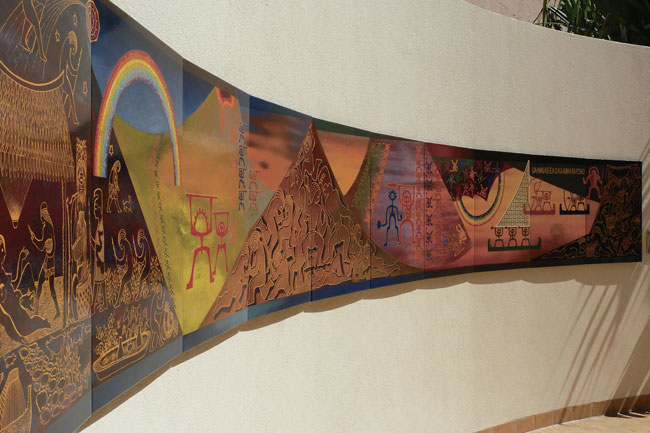A Garden for Reflection
Even in bustling downtown, there’s a place to escape the madding crowd. The courtyard at the Hawaii State Art Museum offers shade, artwork to browse and a place for quiet reflection. The centerpiece of the Sculpture Garden, which opened in May, is a large water-inspired work by Doug Young that pays homage to the YMCA pool that once inhabited the space.
If someone were to sit in the pool and watch time travel, at the turn of the 20th century they’d be in the courtyard of the Royal Hawaiian Hotel. When the hotel was relocated to Waikiki in the 1920s, the building became the Armed Forces YMCA, which made excellent use of the pool. Eventually, a developer bought the old wooden building and poured money into fixing it up before selling it to a Japanese company. When the state purchased the place and turned it into a museum about 10 years ago, they were faced with a dilemma regarding the pool’s cleaning and liability issues. Art was the perfect solution.
“Over the years, thousands of Hawaii people have learned to swim in the pool that was here,” says State Foundation on Culture and the Arts commissioner Peter Rosegg. “It’s a historic building on the National Register, so we had to at least keep the feeling of the pool, and the water art does that. At first when you look at it you think it is water. Kids run down there and kick off their shoes.”
120808-art-02
Many of the pieces displayed by popular Hawaii artists like Bumpei Akaji, Jun Kaneko, Hon-Chew Hee, Toshiko Takaezu and Sean Browne were already in the State Foundation collection, and the garden has proved a perfect spot for their unwieldy size. A few pieces were commissioned for the garden, including the pool art, as well as a set of copper panels by Satoru Abe featuring his trademark moon and tree themes, and a colored glass trellis imbedded with photovoltaic cells by Carol Bennett.
“The art all belongs, literally, to the people of Hawaii,” says Rosegg. “Young and old, everybody can take advantage of it, and it’s completely ADA accessible. My one frustration with the museum and the garden is it’s free, so we can’t say to people, come today it’s free, because it’s always free.
“We call it the ‘rubber slipper museum,’ because it’s a place for people from Hawaii to go and see things that relate to them. The art in this museum and the artists are all tied to Hawaii, so it’s kind of a mirror and we’d really like to get more people in here.”
ALSO SHOWING
Printmakers Think Big
With electric chisels, routers and good old hammer and chisel, a collective of 20-plus artists spent the past three months carving 12 4-by-8-foot blocks of wood. The purpose of the PrintBig project by Honolulu Print-makers is to wrap public consciousness around the concept: Eat Right, Eat Local. With that in mind, the relief prints celebrate the theme of healthy diets, taro, the land, farms and farmers.
“The initial drawing is the most complex part of the process,” says project chairman Sergio Garzon, “because it must be designed and drawn backward and inverted, very much like creating a film negative.”
Finally, a steamroller was used Aug. 4 to make prints from the blocks of wood.
“The prints were made using a pavement roller instead of a printing press,” Garzon explains. “Due to the lack of large presses in Hawaii, we relied on the sheer pressure of our pavement roller, which yields 8.5 tons of pressure per square inch.”
The prints will be displayed, free to the public, in the Mezzanine Gallery of the Honolulu Museum of Art School Aug. 13-25. For more information, contact Laura Smith at 536-5507 or laura@honoluluprintmakers.com.
When: Tuesday-Saturday 10 a.m. to 4 p.m.
Where: No. 1 Capitol District Building (250 S. Hotel St.)
Cost: Free More Info: 586-0305 or hawaii.gov/sfca






